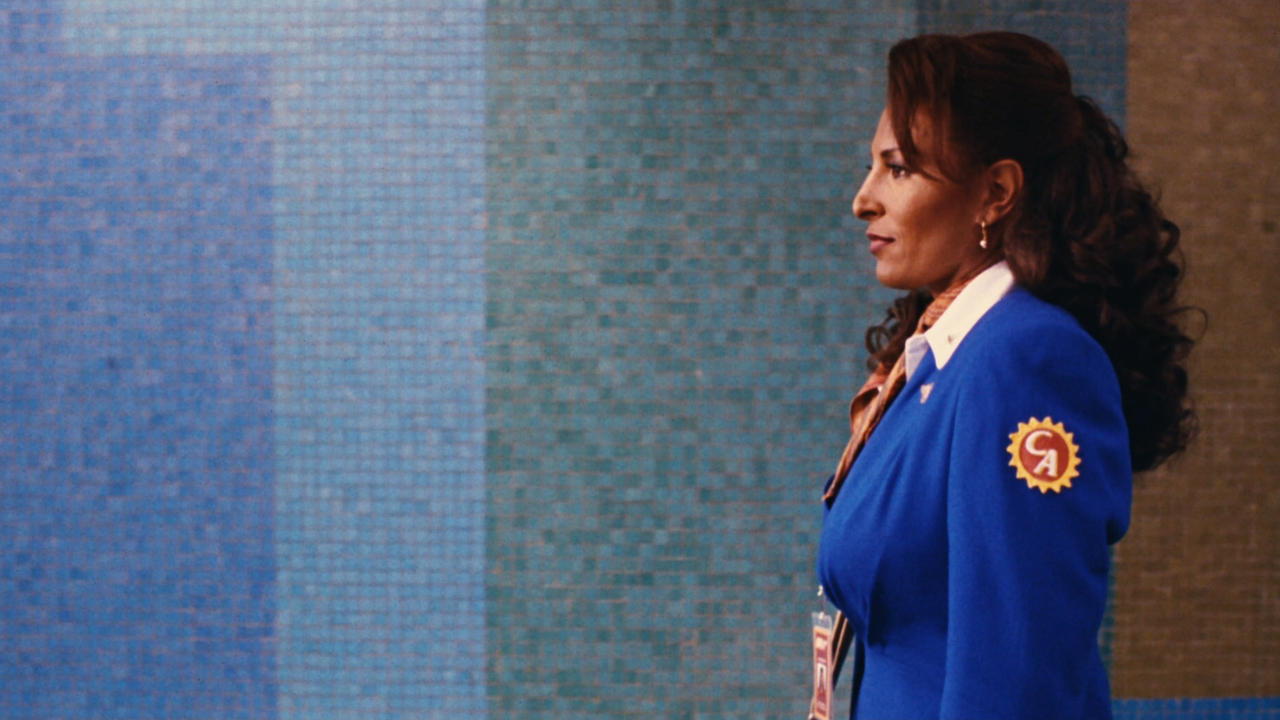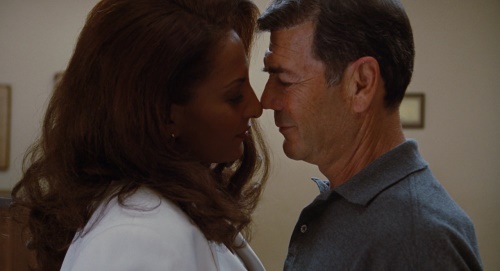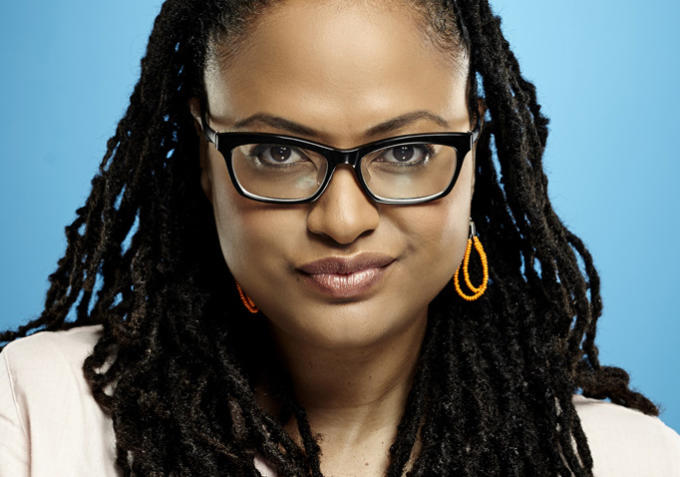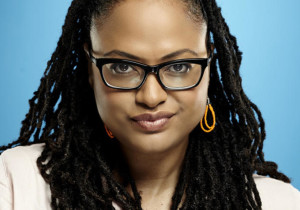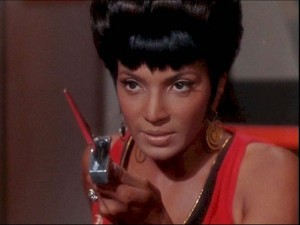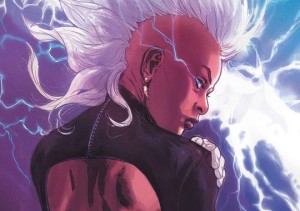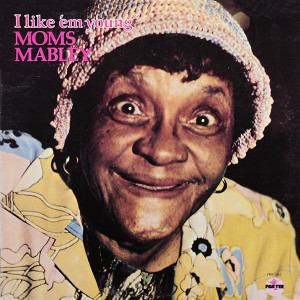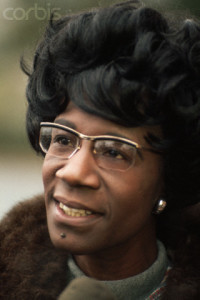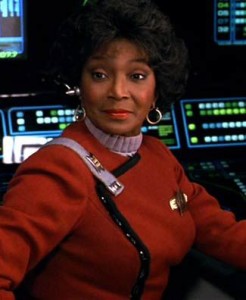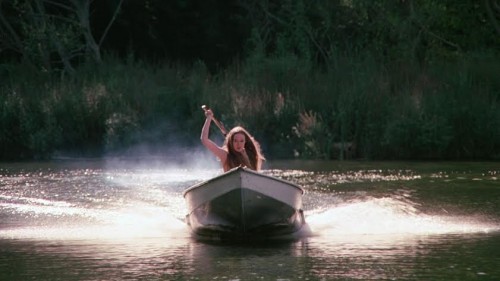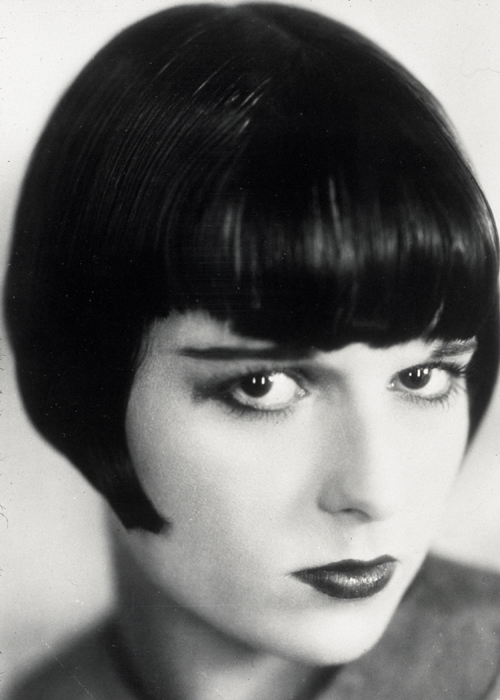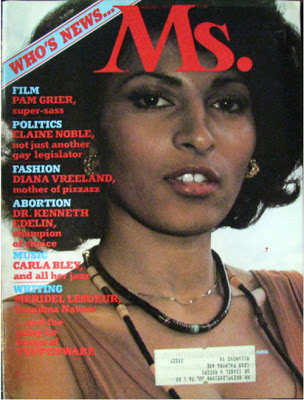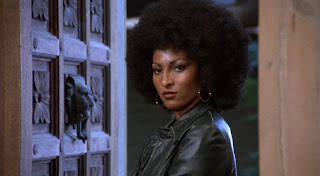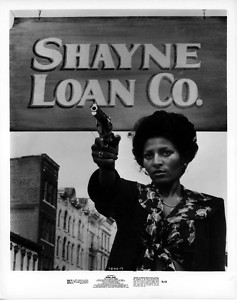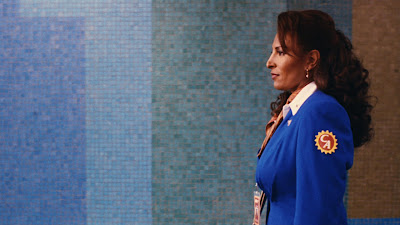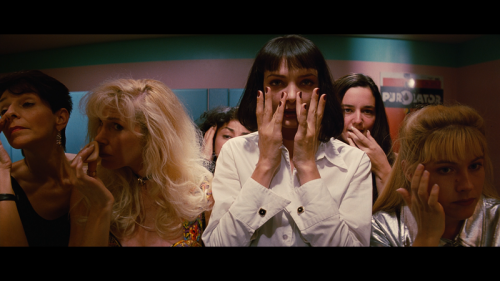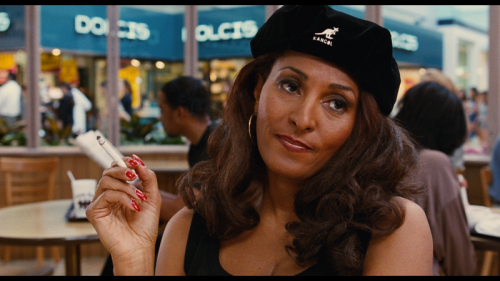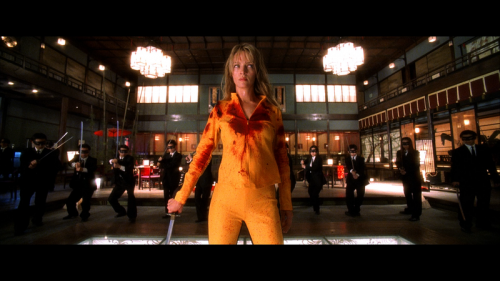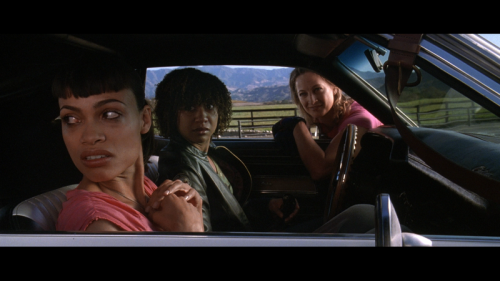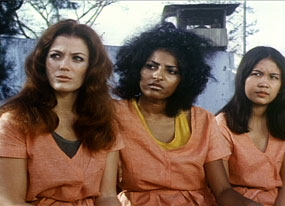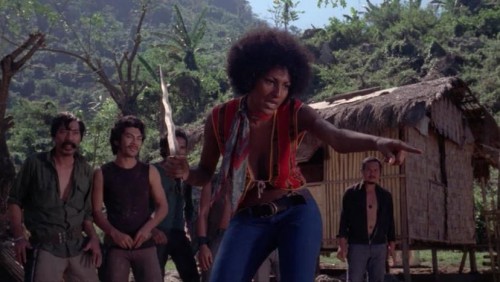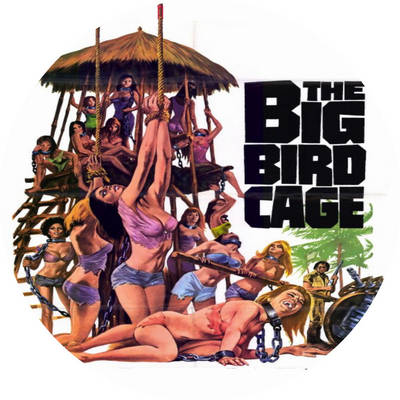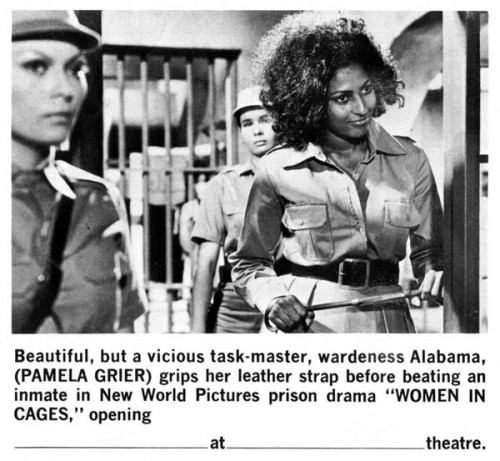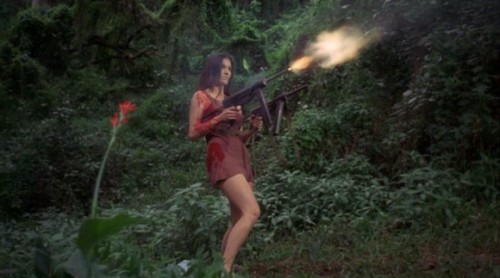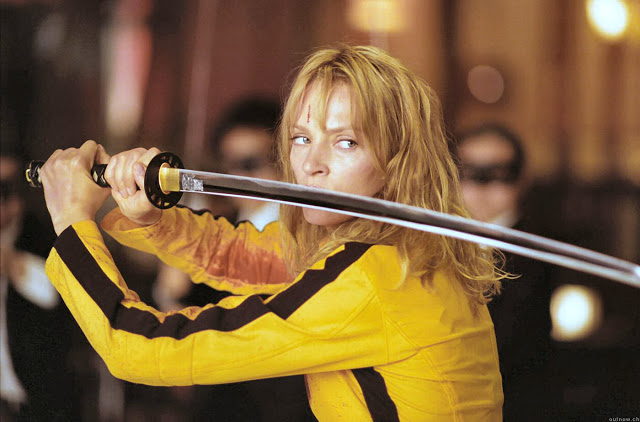This guest post by Rachel Wortherley appears as part of our theme week on Interracial Relationships. Spoilers ahead.
Quentin Tarantino’s third feature film, Jackie Brown (1997), presents a shift in tone from his previous films Reservoir Dogs (1992) and Pulp Fiction (1994). Using Elmore Leonard’s novel, Rum Punch, Tarantino departs from a world largely shaped by men. Gone are the heightened sense of reality and cartoonish characters such as the color-coded thieves in Reservoir Dogs. Unlike his latter films, Kill Bill Vol. 1 (2003), Kill Bill Vol. 2 (2004), Death Proof (2007), and Inglourious Basterds (2009), his characters in Jackie Brown are not professional assassins, deadly women, or covert agents attempting to assassinate a powerful dictator. These features make Jackie Brown Tarantino’s most underrated film. Here, audiences are given characters that function in the real world.
Though Tarantino is known to use other films as a template for his original screenplays, Jackie Brown is first and foremost an adaptation. The fact that Tarantino uses Leonard’s novel as source material, gave Tarantino an opportunity to rethink the way he wrote female characters. Prior to Jackie Brown, the only significant female figures in his films are “gold-digger” Mia Wallace (Pulp Fiction), and the man-eating vampire, Satanico Pandemonium, in From Dusk Till’ Dawn: characters who lack depth and complexity. Rum Punch allowed Tarantino to write a female character who is strong, desirable, morally complex, yet vulnerable. Jackie is no “airbrushed fantasy object”— she is “real,” with real world problems, obstacles, and doubts. She simultaneously exudes a sense of sensuality and capability beyond men.
Jackie Brown, portrayed beautifully by Pam Grier, is a 44-year old Black woman with a rough past, who has been reduced to working as a stewardess for a cheap airline. It is the only job she could get after her arrest for drug possession, while serving as a mule for her pilot ex-husband at another airline. The film begins with Jackie’s physical profile on the airport moving walkway with Bobby Womack’s “Across 110th Street” playing over the credits. The lyrics, “I was the third brother of five. Doing whatever I had to do to survive. I’m not saying what I did was all right. Trying to break out of the ghetto was a day-to-day fight” establishes Jackie’s position within the film’s universe without the use of traditional exposition. The moment Tarantino focuses on her physical profile with the interspersed music, the audience projects an idea of Jackie as confident; a hard worker; someone who has to hustle to survive. Her stewardess uniform presents her as a responsible, professional: one who serves, but also provides comfort and assurance with a tone and manner that puts even panicky passengers at ease. Jackie’s legitimate job — stewardess, parallels the illegitimate one — smuggling money for petty arms dealer, Ordell Robbie (Samuel L. Jackson). He is the “pilot” of the operation, but in times of peril, she bears the brunt of the consequences while keeping everyone calm and collected.
Jackie’s involvement with Ordell gives her the financial security her other job does not provide. But, when she is caught by Detectives Dargus (Michael Bowen) and Nicolette (Michael Keaton), this threatens her livelihood. At this moment, we see her vulnerability, and how much of her troubles result from her relationships with dangerous, erratic men. There is an element of servitude in Jackie’s relationships with these men, but she is no mere victim of circumstance. She willingly acknowledges that her own choices got her to this place.
Hers is a story of self-actualization, of finding her identity. Early in the film, she confesses to a friendly bondsman, “I always feel like I’m starting over. Starting over would be scarier than facing Ordell.” Sacrifice for the sake of self-preservation defines Jackie’s life, to aid her ex-husband and Ordell. Now, she seeks self-renewal. Because of the maturity and vulnerability that she exhibits, audiences generally want her to prevail, and are “okay” with Jackie using the same men who use her to execute the film’s central caper: a high-stakes money exchange involving Ordell and the police, circumstances that Tarantino uses to give importance to Jackie’s actions and to elevate her to the status of a hero.
Most of the men in Jackie’s life want something from her. Jackie’s pilot ex-husband wanted her to smuggle drugs onto their plane; Ordell wants her to fix the problems her arrest has caused for his business; and the detectives wager Jackie’s freedom in exchange for her help in bringing down Ordell. The only exception is Max Cherry (Robert Forster), Jackie’s bail bondsman, who falls in love with her but asks nothing in return. We witness his feelings for her emerge in the first moment he sees her being released on bail. Unlike the confident, put-together stewardess in the opening shot of the film, her hair is wild and untamed, she is without makeup, and her signature stewardess uniform is disheveled. Tarantino decides to describe this moment through use of a long shot, with Jackie walking down a long path. As she advances toward Max, the artificial light of the jail illuminates her silhouette. When Max first sees Jackie, he is transfixed by her image. He sees her true beauty, beyond the mask and the uniform she wears for the world.
Max and Jackie’s interaction is interesting because it contrasts with the romantic male/female relationships portrayed in Tarantino’s other films, which either center on the revenge narrative (Kill Bill, Death Proof, Inglourious Basterds), or a woman in peril (Pulp Fiction, Django Unchained). In Jackie Brown, the central romantic relationship occurs between two mature adults, entering the next phase of their lives. Rather than lovers, they become confidantes, emotionally vulnerable to each other. They barely know one another, yet Jackie almost immediately feels comfortable allowing Max in her home, where her reduced circumstances are apparent. But Max respects Jackie, rather than pitying her. He wants to help her without relegating her to the role of a damsel in distress. He stands at a comfortable distance, but is present in case her plan goes awry. As he watches her successfully execute her plan, Max admires her determination and bravery.
Jackie Brown also marks the first time there is more of a presence of an interracial relationship in a Tarantino film. While Ordell has a “relationship” with surfer-stoner-girl, Melanie (Bridget Fonda), it is reduced to using the other person for personal gain — financially and sexually. Essentially, Ordell and Melanie are the anti-couple in comparison to Jackie and Max. Tarantino gives us two glimpses of interracial romance in Pulp Fiction: Mia Wallace (Uma Thurman), a white woman married to a Black man, Marsellus Wallace (Ving Rhames), as well as, the “blink and you’ll miss it” moment in the chapter titled, “The Bonnie Situation,” where Tarantino’s character is married to Bonnie, a Black woman. In fact, Bonnie’s role is so minimal that it is non-speaking, and consists of a brief image of her walking toward the camera. These dynamics are not fully captured onscreen and there is not enough time spent amongst these couples. Although, the same can be argued for Jackie and Max.
Max purchases the Delfonics record, “Didn’t I (Blow Your Mind This Time)” after hearing it at Jackie’s apartment, because it reminds him of her: not just as she is now, but of her youth, as she was when she first bought the album. It is as though Max hopes to know her by listening to the song repeatedly, while simultaneously maintaining the image of her the first night of their meeting, when he first heard it. In the last scene of the film, Jackie announces her intention to travel around the world — to Spain. She invites Max to come, but he politely refuses. They share a brief kiss and Max returns to business as usual. But, when Jackie drives off, he watches her leave. His face registers one of immediate regret, or longing. Max’s choice is significant for two reasons. By staying behind, he will not risk tarnishing his image of Jackie. Secondly, he allows Jackie to have the freedom, independence, and fresh start that she desires. Jackie finally has a life for herself, and if Max went with her, he might prevent her from living it. She must cut all ties to the past.
The last scene of the film is a tight close-up of Jackie’s face as she drives off, with the familiar sound of “Across 110th Street.” While the song previously existed outside of the universe of the film, this scene depicts Jackie mouthing the lyrics:
Across 110th street
Pimps trying to catch a woman that’s weak
Across 110th street
Pushers won’t let the junkie go free
Oh, across 110th street
A woman trying catch a trick on the street, ooh baby
Across 110th street
You can find it all
In the Street
Through Jackie’s acknowledgement, the song becomes a part of the film’s universe and it represents Jackie’s continued ability to overcome “the pushers” and “the pimps” largely represented by the men, save Max, who underestimated her. Although Jackie experiences a sense of freedom, tears well in her eyes, but the scene cuts and the film ends before they fall. Audiences are left to interpret this in a multitude of ways. The tears can be construed as “happy tears” that speak to the beginning of a new chapter; the idea of loss, or as a bittersweet moment. Jackie is free (and wealthy), but she leaves a decent man behind. The sense of it being a bittersweet moment is sanctioned by the audience. While we waited for Jackie to win against Ordell, we also wanted to see her “win” in love. Their relationship may be viewed as undeveloped, when it is in fact underdeveloped. Their chemistry implies that beyond the narrative of the film, or in a fantasized sequel, Jackie and Max as a romantic unit is possible.
By not blatantly focusing on the racial disparity between Jackie and Max, it speaks volumes in regards to who the film is about. Jackie’s motivations and plans are not demonstrative; they are quiet. These characteristics only add to her mystery. It is silently implied that as a Black woman, she divorces her identity from the men in her life — including a man who, as a white male maintains a sense of privilege in society — and reclaims it for her own.
Rachel Wortherley earned a Master of Arts degree at Iona College in New Rochelle, New York. She currently teaches English at Iona College and hopes to become a full-time screenwriter.
